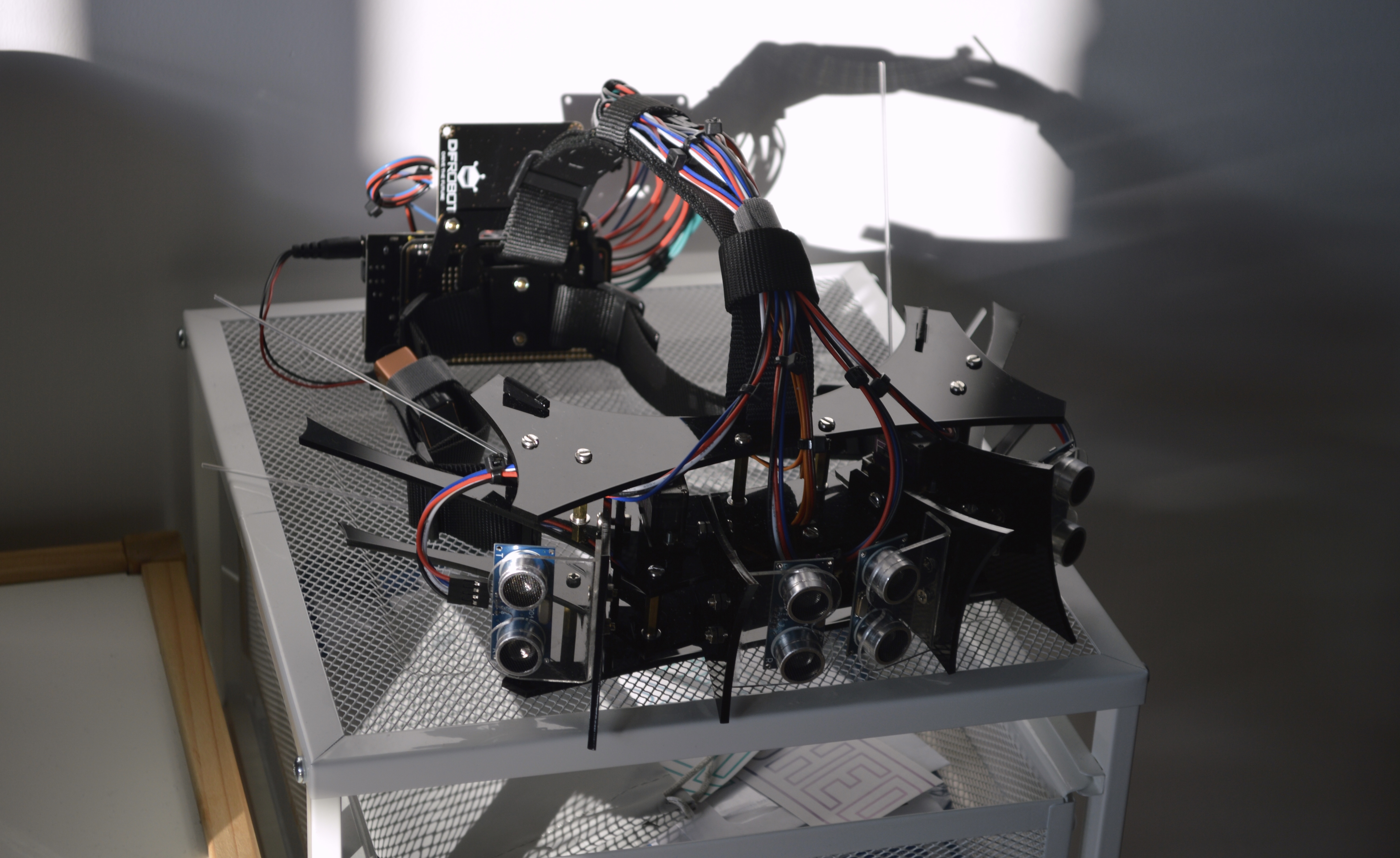
-
Reflection - 12/16
a. What are the specific questions you are attempting to answer in your prototypes?
I tried to create a medium for the integration of animals and humans. It is a question that is posed to ourselves: what is the relationship between humans and animals, between humans and nature.
b. What are the five strengths of your project?
Time for effort. Structured researches. Strong technical implementations. A neat, stylish appearance.
c. What are the five most critical issues for your project?
How a static object tells a narrative? This is the biggest issue with the outcome of this project.
d. What can you do to address these issues, and to solidify the strengths?
Further develop it on the concept more. And figure out how to better demonstrate with video or other materials.
e. What new questions do you have?
N/A
f. What questions need to be answered in order to create a proof of concept prototype?
g. How has this prototype allowed you to engage in your goals within this program? Does this feel like a possible future direction?
It is absolutely a possible future direction. As our major is called design technology, we always discuss the relationships between tech, humans, and nature. This project was an important attempt for me to combine production and theory. Although there is still a gap between the final outcome and the theoretical narrative I set out to develop, this is the space I will further push myself in the future.
Final Project - Prototype 4 - 12/13
Laser cut! Assembly! Sewing! Wiring circuits! Testing!
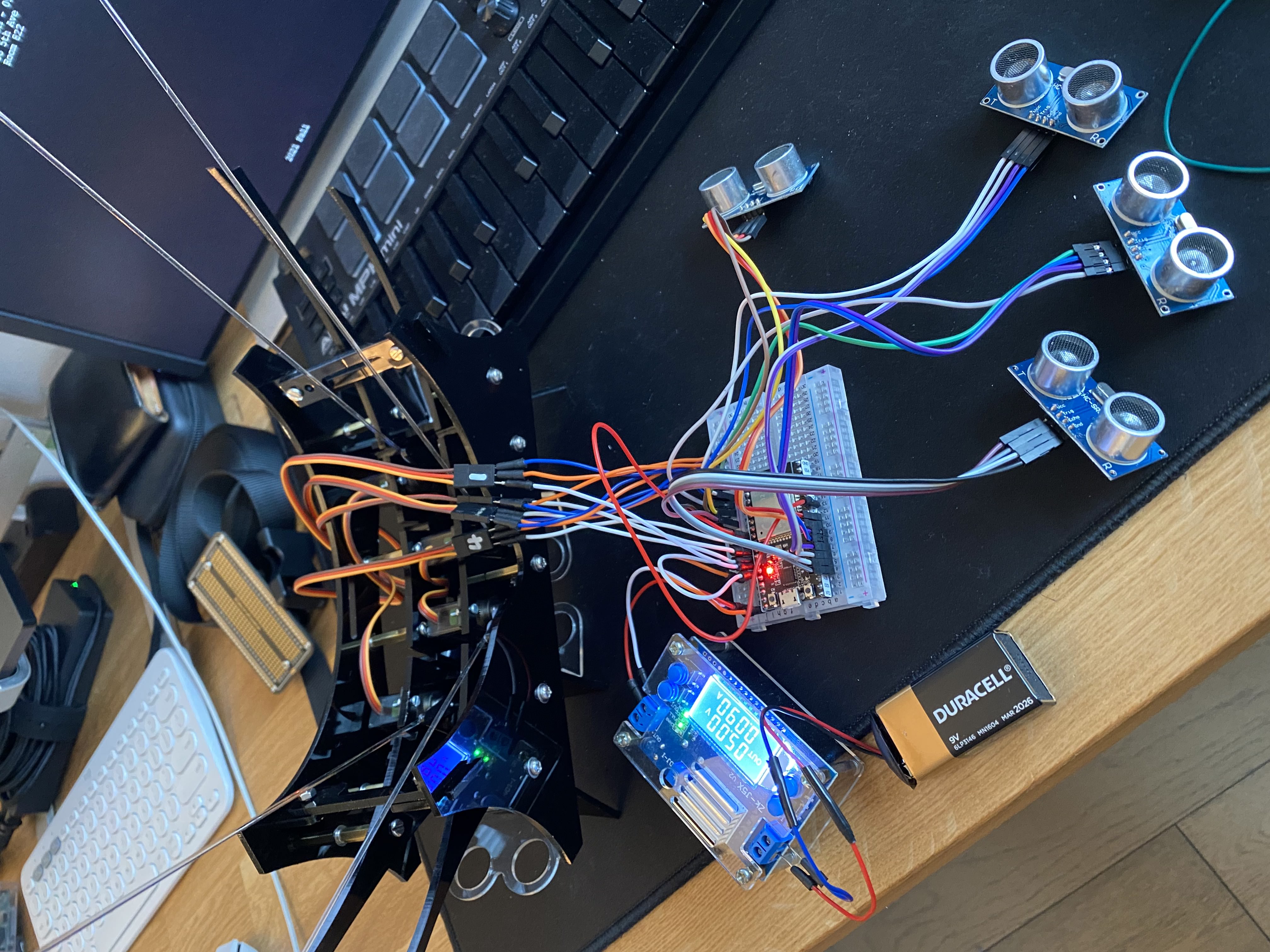
Shot a short, rough video. In progress, more footage is needed.
-
Final Project - Prototype 3 - 12/06
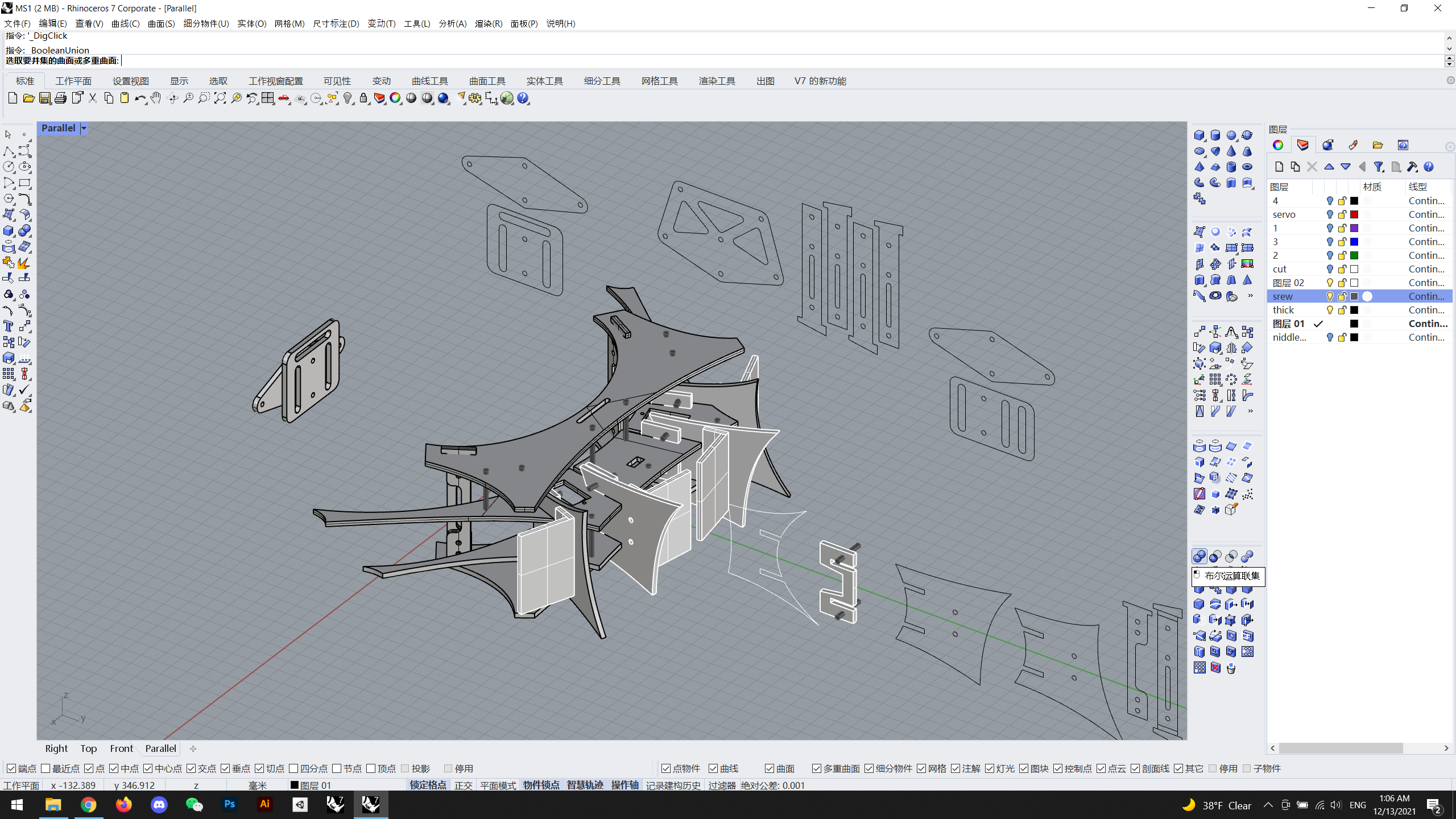
At this stage I was focusing on designing the appearance in the software in preparation for the final production.
My final choice of material was black acrylic. More textures to be achieved in future iterations.
Final Project - Prototype 2 - 12/01
I adjusted the whale's interference logic. I used a decibel detector to measure the environmental noise and apply this value to an interference variable. This variable is created by a random variable, and the range of this random variable is related to the noise level. This variable will be given to the other two modules.
Final Project - Prototype 1 - 11/15
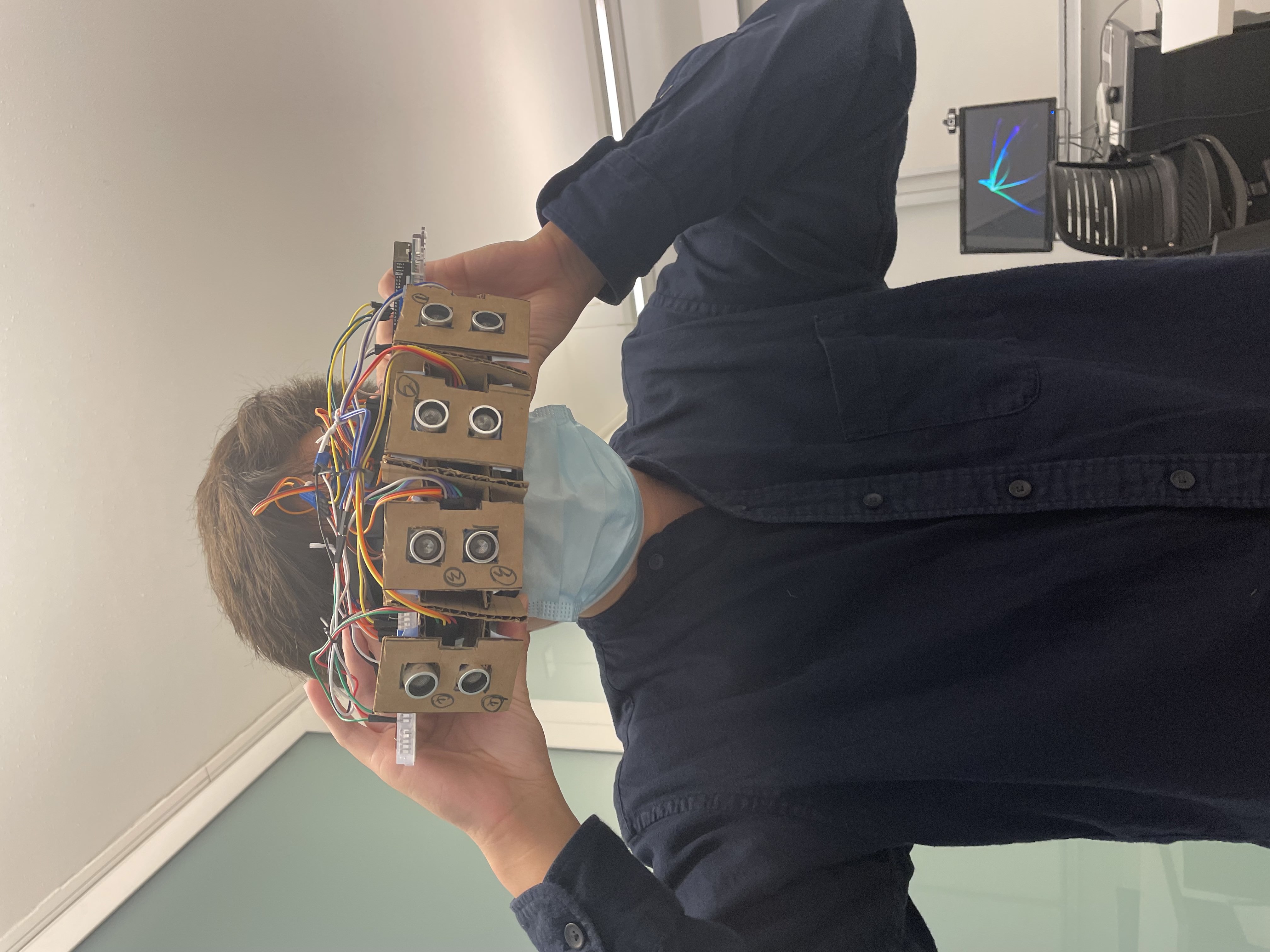
I quickly used cardboard to build the frame of this device, and completed the code for the microcontroller (Arduino Mega). I am planning to use a smaller controller like Aruino nano or STM32 in ther future.
On this prototype design I used various second-hand servos which ran very erratically. I have therefore sourced a better quality mg90 servo.
Final Project - 7 in 7 - 10/25
This week I have been designing the translation logic for my three modules, and done some basic code testing. I have some basic ideas about the construction and assembly of the device. This parts will further polish in the future
Final Project - Midterm Presentation - 10/20
Final Project - Feedbacks - 10/13
Through several feedbacks, I finally chose the direction of converting animal senses to human interactions. I think the outcome in this direction will be more interesting and playful.
I was greatly inspired by Donna Haraway's Cyborg Manifesto. I was also surprised at the consistency between her theory and the manifesto I wrote for the D4TC.
But the Cyborg Manifesto more essentially breaks down the concept of boundaries:
Three crucial boundary breakdowns: The breakdown of boundaries between human and animal, animal-human and machine, and physical and non-physical.
She explains these breakdowns from a very underlying logic: because the study of evolution and biology has made human and non-human life to be identical.
Machines become active and self-developed. When these conceptual barriers are broken down, the subtleties of these in-betweens become interesting.
My manifesto revolves around the phrase "The Fusion of Boundaries”. From a systems perspective, I would like to discuss the integration of city and natural environment, and the transformation of the subject-object relationship between humans and non-human species.
This idea has been put into practice in my late undergraduate projects. For example, Tsingcrow University and Porifera-Bricks are projects that explore such relationships more statically in terms of the larger system and do not extend to individual interactions.
And this time the project starts from the immersion of human senses and should be able to make some differences. The main challenge now is to solve the logic of the narrative: What kind of perspective, interaction, experience can people get through animal senses?
Final Project - Point of View - 10/04
Context: what are you planning to research or investigate, and why.
Human senses are classified in terms of exteroception and interception. External sensory perceptions include sight, smell, taste, hear, and touch.
Internal sensory perceptions include the sense of balance, spatial orientation, proprioception (body position), and nociception (pain).
And these internal perceptions can transfer into a further sense of feeling
Animals’ senses are also worth studying. Some animals are able to detect electrical and magnetic fields, air moisture, or polarized light, while others sense and perceive through alternative systems, such as echolocation.
Can we extend the organs so that people also get the sensory signals of animals?
Research Questions: based on your initial research, name 2 questions, one more general and one more specific, that you’d like to investigate through your Final Project.
1.How to extend human sensory perceptions?
2.1 How to parametric human’s internal sensory perceptions as a control input to computer?
2.2 How people perceive the senses of animals?
Project principles: Develop a set of principles or values that will guide your Final Project.
1.Summarize the necessity for sensory extension, what kind of interaction scenarios can use this new information inputs.
2.By analyzing the circulation of the internal sensory system of the human body, find the points where can be intervened.
3.Take inspiration from animal senses and translate to a new form of interaction.
...
Precedents: what are 3-5 related works that demonstrate some aspect of what you would like to create.
-See Yourself Sensing: Redefining Human Perception by Madeline Schwartzman (a book I am planning to read)
-Taste of Light by Daniel Tauber & Lukas Franciszkiewicz
-Upside Down Goggles by Carsten Höller
-Female Sex Robot by Paul Granjon
Final Project - Research Group Sharebacks - 09/29
Because our groups have two questions which have sort of relations between them. We designed a buffer question in-between to land our research field.
Our group research questions:
1.How the human sensory system transfers information between each other?
2.How can we incorporate human senses to virtual reality?
3.How might we simulate human senses during human-computer (VR) interaction, so people with motion sickness can use VR technology in education,
remote virtual collaboration, or in gaming comfortably for longer period of time?
In particular, we divided these questions into four major field, Ergonomic (Huian), Motion Sickness (Cici), Immersion / Multi-sensory (Hong), Accessibility (Nassiba).
My research field:
As one of my questions previously mentioned, I am always interested in the new medium of human-computer interaction. It has a possibility that associate with unremarked or extended human senses.
Throughout my research, the concept of internal sensory perceptions draws my attention. Balance, proprioception (perception or awareness of the position and movement of the body), nociception (the perception or sensation of pain),
and even six-sense are all included. How these perceptions could combine with immersion?
The research about motion sickness of VR from Cici also brings connection to my idea. “Mismatching”, the most essential reason why we suffer from such motion sickness, seems to have strong relationships with internal sensory perceptions.
I was thinking about the possibility of creating new controllers to guide new interaction behaviors.
Final Project - Affinity Group - 09/22
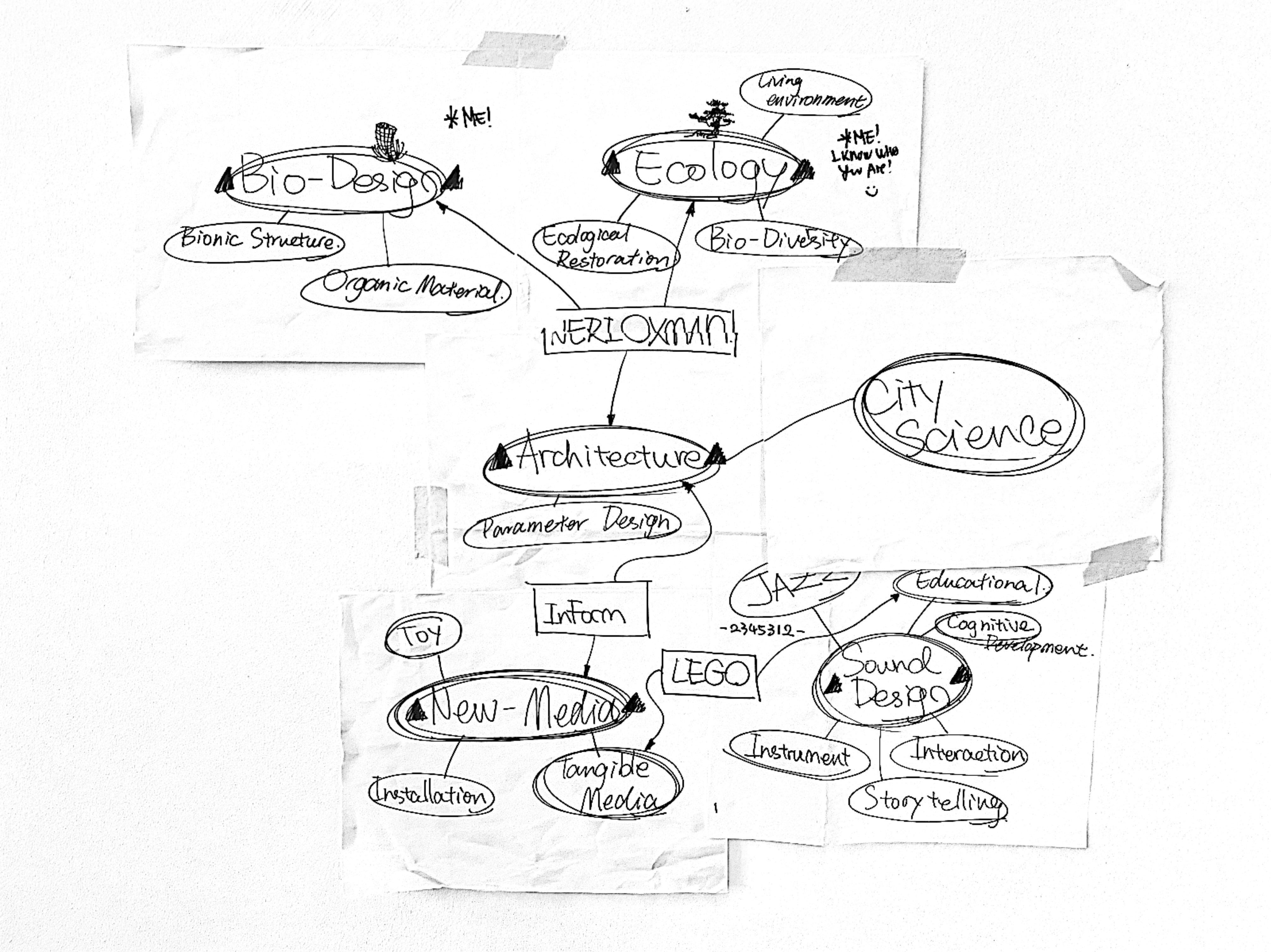
In the first practice, I landed on every field I am interested in. Industrial design, architecture, bio-design, ecology, tangible media are basically the fields I have practiced during my undergrad studies.
Sound design is something I have always been passionate about. I also tried to find some intersections between these interdisciplinary areas.
The three questions I raised is:
1.How we design for the “nature”, or nonhuman species?
2.How human senses transfer between each other? Or how we design with the synesthesia?
3.How we design a system that blurring the concept of boundaries?
The first two questions have a relatively clear direction, while the concept of the third question is still unclear for myself.
Fortunately the second question was selected and integrated with the question posed by Nassiba.